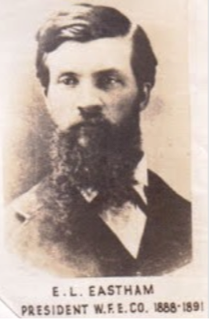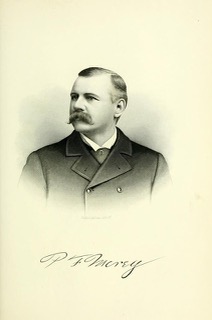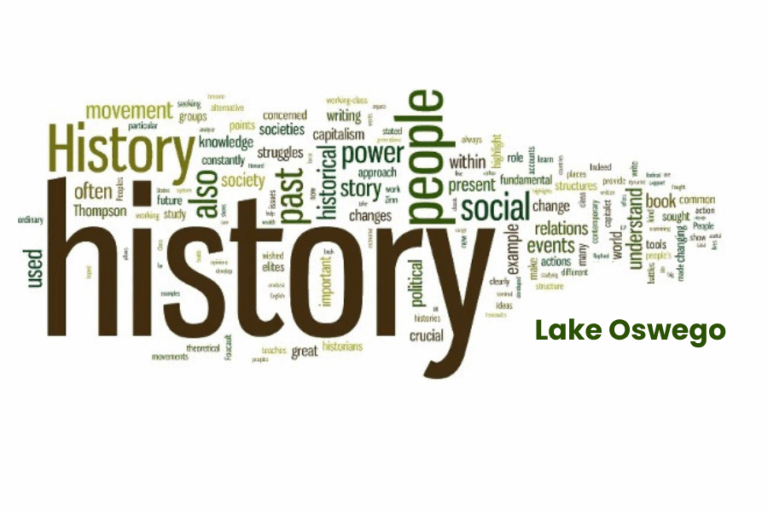Parker F. Morey (1847-1904) for whom the Glenmorrie area of Lake Oswego is named, and Edward Lawson Eastham (1849-1891), born and raised in Oregon City, were men of power–financial power and electrical power.
Eastham, a prosperous Oregon City lawyer and business man, organized and started the Bank of Oregon City in 1881. With profits from the bank, he purchased the almost worthless Walla Walla water works in 1881, Just two years later, under his direction, the water works system improved dramatically and became so profitable that Eastham returned to Oregon where he invested in and gained control of the hydroelectric power plant at Willamette Falls in Oregon City.

Forming The Oregon Falls Electric Company, he was the first to transmit electric power long distances, sending electricity twelve miles from Oregon City to Portland. While continuing to develop plans for supplying electricity over long distances, Eastham met Parker Farnsworth Morey, a machinist turned mechanical engineer who migrated to Oregon via California from Machias, Maine.
On a business trip to the Northwest, Morey discovered that people in Portland could not install hydraulic elevators because the ground was too unstable. Inventor that he was, Morey devised–and patented–a telescoping ramp to solve the problem. His invention became so successful that he moved to Portland; purchased a large parcel of land in Glenmorrie where he built a ranch; and founded the Portland Hydraulic Elevator Company.

After Eastham’s death in 1891, Morey acquired the assets of the electric company and was elected president. In 1892 he merged United States Electric Lighting Company with General Electric Company Of New York. The merger resulted in the formation of Portland General Electric, replacing the conglomeration of his elevator company and Easton’s electric company. PGE’s first president, Morey remained at the helm until his death in 1904.
Morey also acquired another of Eastham’s assets-his widow. A widower himself, Morey courted and married Clara Eastham. Many people say Morey married for money. Perhaps he married for electricity AND MONEY?
Parker Morey wasn’t just about electricity; he also wanted to bring pure drinking to Portlanders, who were getting eighty percent of their water pumped from the polluted–even back then– Willamette River by the Portland Water Company. Dissatisfaction with Portland Water Company running rampant, Morey proposed to Portland city officials in 1885.damming the Bull Run River and delivering ALL of Portland’s water via his elevator company instead of splitting the delivery between his company and Portland Water.
A local newspaper ran a story about Morey’s proposition, pointing out that Morey’s company received $7200 a year to provide one-fifth of the city’s water, while Portland Water received only $3600 a year for furnishing four-fifths of the water. The article also mentioned that Morey’s electric company earned $18,000 a year to furnish the city’s lights. Politicians were skeptical about Morey’s proposition because it seemed self-serving; but finally adopted it only to have legal action strike it down.
Sources: Photos – Findagrave Content-Oregon Encyclopedia, Access Genealogy, Geni.com
More about the lives and accomplishments of Edward Eastham, Parker F. Morey and the founding of the Glenmorrie area of Lake Oswego can be found in my book History Soup – stories of Oswego’s past available on Amazon : https://tinyurl.com/2kw55pz3 or directly from History Soup Press histsoup.press@gmail.com

We’re thrilled to welcome Nancy as a contributor to the Palisades Neighborhood Association’s monthly newsletter, where she’ll be serving up fascinating historical stories about Lake Oswego. Get ready to dive into the rich, colorful past of our community—History Soup style! Find out more about Nancy on her website, or purchase her books available on Amazon.
Nancy Dunis is a passionate public historian, dynamic storyteller, and published author with a flair for bringing the past to life. As the founder of History Soup Press, she’s the creative force behind the History Soup book series and The HistoriConnection blog. For over 20 years, Nancy has been sharing captivating historical nonfiction through newspaper columns, blogs, magazines, social media, newsletters, and three compelling books.
With a special focus on barrier-breaking women, infamous men, and unforgettable events, she uses a wide range of audience engagement techniques to make history accessible, exciting, and relevant.


